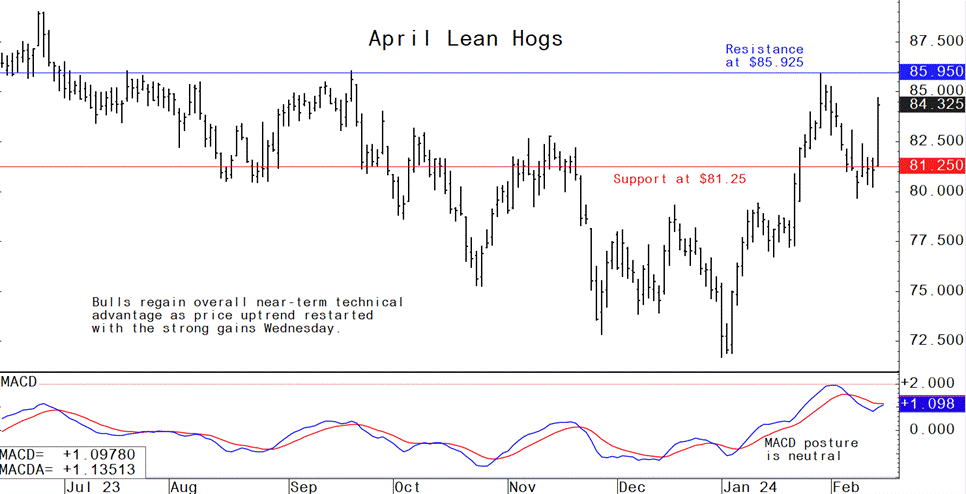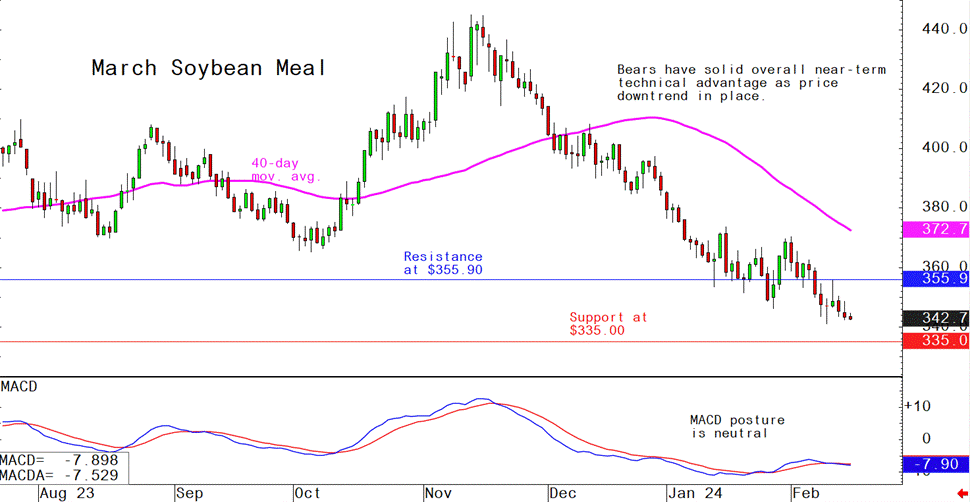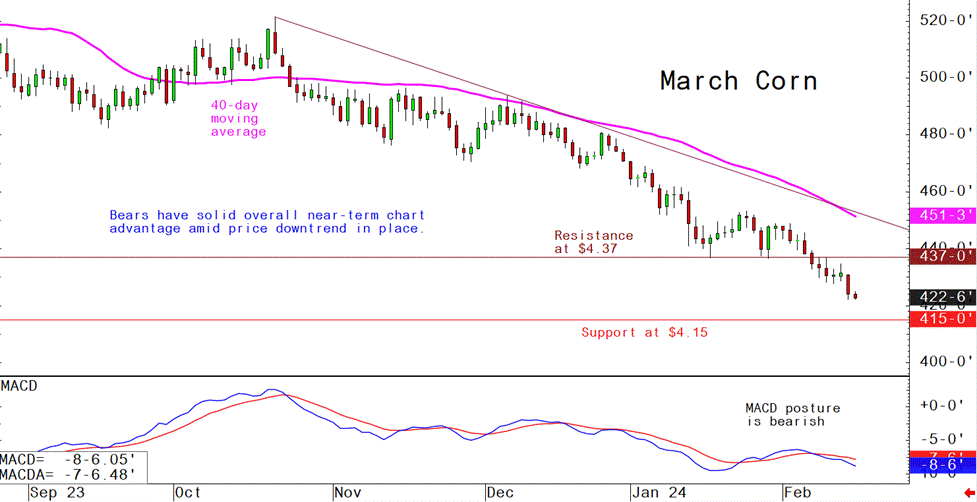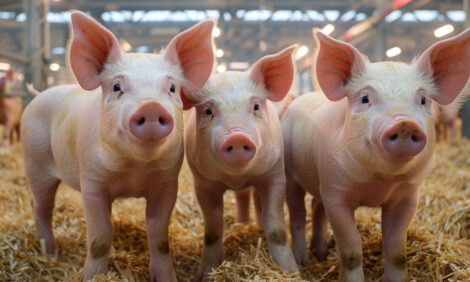



Pig outlook - Lean hog futures post strong rebound
Livestock analyst Jim Wyckoff reports on global pig newsLean hog futures prices surged Wednesday, negating nearly all of the selling seen over the last two weeks. After four consecutive sessions of choppy sideways trade, bulls came back to life, to keep a price uptrend alive on the daily bar chart for April lean hog futures. The CME lean hog index rose 41 cents to $74.11 today (as of Feb. 12) and was projected to rise another 49 cents to $74.60 Thursday. Despite strength in the CME lean hog index, wholesale pork prices continue to struggle at the $90.00 level. As cutout nears that level, packers take advantage of higher prices to move substantially more pork.
USDA annual Ag Outlook Forum projections on pork
Hogs: U.S. pork production is projected at 27.88 billion lbs., up about 2% from last year. Exports are expected to rise 3.8% to 7.080 billion pounds. Cash price: $60.00, up $1.41 from last year.
USDA’s latest livestock report
Pork/Hogs
Gross Processors’ Spread Above a Year Earlier in January on Strong Belly Prices Demand for pork bellies appears to have driven the average January 2024 estimated wholesale carcass cutout to a value above that of a year earlier, something not seen since December 2022. The wholesale cutout value of the pork carcass in January was $87.01 per cwt, 7.4% higher than the January 2023 value. With prices of live equivalent 51%-52% lean hogs averaging $49.83 per cwt in January 2024—more than 7.4% below hog prices a year ago—processors’ gross spread exceeded year-earlier levels in the first month of 2024. Toward the end of January, however, seasonally rising hog prices and slower rises of belly primal values effectively reversed the course of processors’ spreads. By the end of January, processors’ gross spreads, although still year-over-year higher than in late January 2023, had declined. While demand for pork bellies may have elevated cutout values for a few weeks, it is doubtful that a single cut can sustain strong spreads for the pork market overall.
Improving pork demand expected to support hog prices in 2024
Stronger demand for selected pork cuts and a slower pace of slaughter throughout 2024 will be key factors in raising hog prices beyond initially expected price levels. Strong belly prices in the first quarter should combine with the slower paced first-quarter hog slaughter to push average first-quarter prices of 51-52% lean hogs to $55 per cwt, up $4 per cwt from last month’s first-quarter forecast. Second-quarter commercial pork production is expected to be unchanged from last month’s forecast at about 6.6 billion pounds, but improving demand is likely to push second-quarter hog prices to $62 per cwt, more than 9% higher than in the same period last year. Higher production in the third quarter—almost 6.8 billion pounds, more than 4% higher than production in the same period last year—will likely offset continued improving domestic, and solid foreign demand, to lower hog prices almost 5% from a year earlier, to $66 per cwt. Fourth-quarter hog prices are raised $1 per cwt from last month’s forecast to $56 per cwt, almost 5% greater than last year, on pork production of about 7.4 billion pounds, almost 3% greater than fourth-quarter production last year. Improved domestic pork demand compared to 2023 and competitively priced U.S pork in foreign markets are likely to be the most important factors supporting hog prices in the fourth quarter of 2024.
Quarterly pork exports for 2024 are revised upward on strong December data
For the first quarter, exports are expected to be 1.765 billion pounds, 5.8% higher than same[1]period exports in 2023. Second-quarter exports are forecast at 1.785, virtually unchanged from the second quarter of 2023. Shipments of 1.645 billion pounds are expected in the third quarter, which would be about 6.6% higher than exports in the same period of 2023. Fourth[1]quarter exports are expected to be 1.885 billion pounds, about 3.4% greater than same[1]period shipments in 2023. Pork export forecasts for 2024 total about 7.1 billion pounds, up about 3.8% over the 2023 total of 6.8 billion pounds. This implies that 25.4% U.S commercial pork production will be exported. Production and export forecasts, combined with expectations for pork stocks changes, also imply a retail per capita disappearance of 50.7 pounds, up 1.02% over 2023.
Pork oversupply sparks economic concerns; industry seeks solutions
The Wall Street Journal reported on the challenges facing the U.S. pork industry, which has become overly efficient, resulting in an imbalance between supply and demand. Despite producing various pork products like tenderloin, ham, sausage and bacon, there’s insufficient demand to absorb the surplus.
Factors contributing to this imbalance, the article notes, include the industry’s focus on efficiency, the perception of pork as less desirable compared to chicken and beef, and misconceptions about pork’s preparation and healthiness. The industry is exploring various strategies to address these challenges, such as targeting new overseas markets, repositioning pork as an affordable alternative to beef and promoting fattier, more flavorful pork breeds. However, there’s no consensus on the best approach. Furthermore, the article highlights the financial strain on pork producers, with farmers losing money on each pig due to shrinking profit margins. If the industry fails to attract younger consumers, pork consumption is projected to decline further. To stabilize profits, the industry seeks to engage US consumers, invest in marketing campaigns and innovate products to meet changing consumer preferences and lifestyles.
The next week’s likely high-low price trading ranges:
April lean hog futures--$82.00 to $88.00 and with a sideways-higher bias
March soybean meal futures--$335.00 to $365.00, and with a sideways-lower bias
March corn futures--$4.15 to $4.40 and a sideways-lower bias
Latest analytical daily charts lean hog, soybean meal and corn futures












